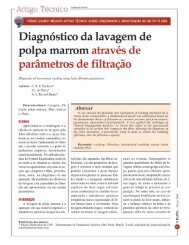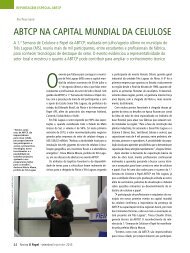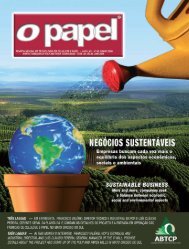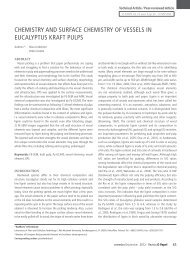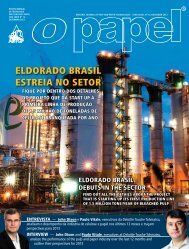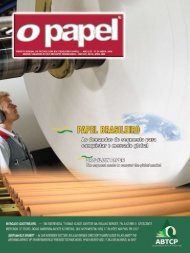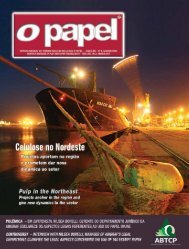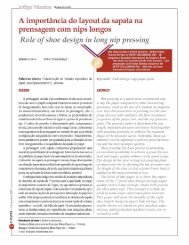You also want an ePaper? Increase the reach of your titles
YUMPU automatically turns print PDFs into web optimized ePapers that Google loves.
O <strong>Papel</strong> – What was your perception about the pulpand paper industry before becoming Klabin’s CEO and whatpeculiarities did you notice upon joining the sector?Fabio Schvartsman – I believe that my initialperception was the same as that of most people outsidethe sector: a negative vision, associated to deforestationand bad environmental habits. I also perceived the pulpand paper industry as a mature sector, with no big thingshappening. Evidently, after joining the sector, I saw that thereality is the opposite of what I thought. I saw that the sectorin general and Klabin particularly are very committed tosustainability and that the entire production chain respectsthe environment. Another misinterpretation I corrected afterjoining Klabin was the idea that this was a mature sector.Today, I see the exact opposite: an extremely vibrant sector,full of opportunities and constant changes. To eliminatethese myths, which still surround the paper industry, Klabincarried out an institutional advertising campaign strictlyrelated to environmental matters. We were absent in themedia for many years, and this is just the first step to showthe company’s true conduct. We intend to intensify this typeof action.O <strong>Papel</strong> – In looking back at your administration so far,what was the first challenge you overcame?Schvartsman – As soon as I took over as Klabin’sCEO, my goal was the improve company performance.This was translated by me to the organization as aneffort to reduce costs, since there was a clear opportunityat Klabin’s main production unit, located in TelêmacoBorba, Paraná state. Upon identifying this opportunity, Ishared my impressions with executives at the plant andreceived not only very clear transparency in the reasonsfor the situation to be like it was, as well as commitmentto face the situation and improve it. It is important topoint out that this was a process very different fromthose you imagine when talking about reducing costs.We contracted more professionals and we improvedorganizational climate, which led to very important gains.The project was accepted as being the natural path forthe company’s development.O <strong>Papel</strong> – What practical changes led to conquering thismajor objective?Schvartsman – I will begin mentioning a few symbolicchanges but that had important results, such as the fact thattoday all company directors share the same work setting.We literally eliminated all walls that separated them so thatthey could work together and discuss matters more fluently,strengthening the idea that everyone is headed in thesame direction. A second important aspect: upon verifyingthe company’s exaggeration in outsourcing activities, wereduced costs by eliminating some of these services. Thisled to the contracting of more company employees. Atthe same time that we executed these changes, we alsoaltered the executive compensation system. Compensationbecame much more based on results. Upon the definitionand fulfillment of goals, executives receive highercompensations, including shares – a practice that was notcommon at Klabin before I joined the company. All theseinitiatives produced important changes in company climateand were very favorable in modernizing the managementsystem as a whole.O <strong>Papel</strong> – Personally, what is your motto for assumingprofessional responsibilities at the helm of a century-oldcompany?Schvartsman – I don’t know if I can consider it a motto,but I believe that managing a company should be somethingextremely simple. This pursuit of simplification has workedwell at Klabin. With a lot of analysis, observation andinteraction with all company areas, I tried to discover whatKlabin had that was valuable and what didn’t work all thatwell. Upon identifying these aspects, I tried to preserve whatthe company had in terms of positive and improve whatwas not going so well. Throughout my professional career, Ialso learned that nobody works alone. A united and alignedgroup produces much better results than a fragmented highqualityteam. So, I set out to build a homogenous and unitedgroup focused on the same objective: to make Klabin a biggerand better company. In my day-to-day routine, I try to avoiddiscussing plant problems only with industrial directors orcommercial problems only with the commercial directors; Itry to see that all matters are discussed as a group, so thateveryone understands why things are being done in such away – that is, shared management where I do nothing morethan ensure that people are exchanging ideas the entire time.As I get everyone to discuss everything in front of each other,I, as leader, expose myself. The only way to make this methodwork is to be willing to expose myself and even be criticized- which normally is very difficult for a leader. I see it as anexercise of humbleness that helps adopt the right attitudes forthe company and build this team spirit we seek.O <strong>Papel</strong> – What are the next steps foreseen for thecompany? What is the status of projects announced?Schvartsman – The only project approved at the momentis the paper bags machine in Santa Catarina, involving aR$220 million investment. The project is at an advancedexecution stage, and the machine, with a production capacityEven thoughKlabin has theforest areas, it isseeking financialinvestors tocontribute withcapital for thepulp projectin Paranáand createa companyindependentfrom Klabin S.A.novembro/November <strong>2012</strong> - <strong>Revista</strong> O <strong>Papel</strong>71



